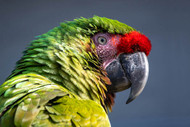Military Macaw Fact Sheet
Posted by Military Macaw, Military Macaw diet, Military Macaw behaviour on 9/1/2024
Find out about the Military Macaw.
Scientific name:
Ara militaris
Description:
The Military & Great Green Macaw (Buffon?s) are often confused. The most obvious differences are the larger size and more massive beak of the Buffon?s and its lighter shade of green.
For everything you need for your Military Macaw please click here.
Adult length nominate race:
60 ? 70cm, males usually larger. The tail accounts for about half the total length ? but it is not as long as that of the Scarlet Macaw, for example.

Sub-species:
Nominate race Ara militaris militaris from north-western Venezuela, western Colombia and Peru is well known in Europe. Ara militaris mexicana from Mexico is slightly larger but plumage is similar. It is better represented in aviculture in the USA. Ara militaris boliviana from northern Argentina and Bolivia is the rarest sub-species in aviculture. It is recognised by the larger brown throat patch.
The tail colour is mainly dark red with blue at the tip in militaris and rusty-red to orange-red, sometimes also yellow-orange, with blue at the tip, in Buffon?s. The plumage is alike in male and female in both species. However, Buffon?s is much rarer in aviculture and much more expensive to purchase.
Immature birds:
Have grey eyes, and the tail is shorter.
Adult wingspan:
About 100cm (40in)
Adult weight:
900-1050g
Expected lifespan:
Sixty years
Status in wild:
Vulnerable. Appendix I of CITES since 1987. There has been a serious decline in recent years due to loss of habitat and trapping for the pet trade or theft of young from nests.
It occurs in Mexico but is now absent in the rest of Central America. It became extinct in Guatemala during the last two decades of the 19th century or the early 20th century. According to the French ornithologist Adolphe Boucard writing in 1878, Military Macaws were nesting in inaccessible ravines near the Fuego-Acatenango volcanos in central Guatemala.
This Macaw, formerly resident in the western highlands, was said to be the region?s first documented vertebrate extinction in historical times.
In South America it is found in western areas, in Venezuela, Colombia, Ecuador and Bolivia. However, its distribution is not continuous and is increasingly becoming fragmented. It was last recorded in Argentina in 1991. This shows how its range is gradually shrinking.
These Macaws are found in small localised mountain populations and are absent from huge areas. They are mainly birds of the mountains, occupying habitats between 500m and 1,500m. Domestic trade (for pets, feathers and probably also killing for food) is a huge threat to its survival.
Popularity
The Military Macaw is a handsome bird and highly intelligent. So why is it not more popular? Perhaps the reason is that the large Macaws are perceived as flamboyant with more gaudy colours than other Parrots ? blues and reds.
Parrot keepers are often initially attracted by colour rather than personality. By any standard the Military is an eye-catching bird with the dense, bushy scarlet feathers of the forehead, a feature it shares only with the Great Green or Buffon?s Macaw.

When excited the bare skin of the facial area blushes bright red, almost matching the adjoining red feathers. Also, it then moves its head up and down and raises its head feathers.
Diet:
Military Macaws are not as dependent on the fruits (nuts) of palm trees as some other Macaws but these do form part of their diet, so anyone living in areas where palm trees grow can provide this natural and oily element of their diet.
They appreciate walnuts, Brazil nuts, almonds, etc, and should receive several each day. The usual fruits, vegetables (including corn on the cob) and seeds must be offered. Militaries will also take foods such as boiled maize, sprouted mung beans and chick peas, hawthorn berries and elderberries.
Aviary
A good deal of thought should be given to aviary accommodation before a pair of Military (or any large Macaws) is purchased. In my experience, Militaries do best when they have no close neighbours or their aviary has solid walls that screen them from other Macaws. A ?detached? aviary would be a good location.
Height is very important ? ideally not less than 3m (10ft). Minimum length of 6m (20ft) is recommended. The width is less important but 2.4m (8ft) is suitable. Some people keep them in smaller enclosures but seem to give inadequate thought to their quality of life. They need to fly and will not do so in a small aviary.
Click here for Military Macaw cages.
Macaws enjoy walking on the ground and grinding up stones or just investigating. A good surface is shingle (small stones) as this can be hosed or pressure-washed to keep it clean.
Fresh cut branches for gnawing and for perches are important. In Europe apple and hazel are good. Willow is suitable for gnawing but too easily destroyed for perching.
Pet potential:
A committed owner who can devote a lot of time to it is needed if a Military Macaw is to have a good life in a home. An important requirement is an outdoor aviary where the Macaw can be placed for a few hours daily, weather permitting.
Hand-reared young can make delightful and affectionate companions for the few people able to provide the necessary quality of life and who are tolerant of their loud voices and destructive habits. However, they will be less destructive in the home if provided with a fresh cut branch on a weekly basis.



